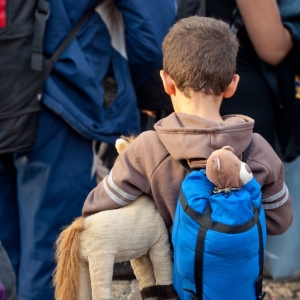
En 2015, la Organización Internacional para las Migraciones (OIM) desarrolló un Marco de Gobernanza de la Migración (MiGOF) para ayudar a los Estados a definir los elementos esenciales que constituyen la base necesaria para una “política de migración bien gestionada” a nivel nacional. El MiGOF fue bien recibido por los Estados Miembros de la OIM el mismo año. Los Indicadores de Gobernanza de la Migración (IGM) han sido desarrollados para operacionalizar el MiGOF a través de cerca de noventa indicadores agrupados en seis dimensiones claves de políticas públicas.
Haga clic en la rueda para obtener más información sobre las seis dimensiones de la gobernanza de la migración incluidas en el MiGOF y los IGM.
Los IGM son una herramienta basada en el análisis de las estructuras de la gobernanza migratoria que presenta una serie de pautas sobre los instrumentos que el Estado podría usar para desarrollar su gobernanza. Los IGM evalúan únicamente el marco institucional, jurídico y de políticas públicas en materia de migración, sin entrar a evaluar su implementación en la práctica. Los IGM funcionan como un marco de referencia que permite identificar medidas que los países podrían adoptar para fortalecer sus estructuras de gobernanza de la migración. El objetivo de los IGM es contribuir a la conversación sobre la gobernanza migratoria definiendo lo que podría ser una “política migratoria bien gestionada” en el contexto de la meta 10.7 de los Objetivos de Desarrollo Sostenible (ODS).
Para obtener más información sobre el proceso de los IGM, haga clic aquí
Los indicadores de este dominio analizan los derechos de los migrantes a los servicios sociales básicos, como la salud, la educación y la seguridad social. Estos también presentan los derechos de los migrantes a la reunificación familiar, al trabajo, a la residencia y a la ciudadanía. La ratificación de las principales convenciones internacionales también se incluye dentro de este dominio.
Los indicadores de esta categoría se utilizan para definir la medida en que las personas migrantes tienen acceso a determinados servicios sociales, como la salud, la educación y la seguridad social. También remiten a las medidas adoptadas para garantizar la integración y el acceso al empleo.
Los indicadores en este dominio evalúan los marcos institucionales, legales y regulatorios de los países relacionados con las políticas migratorias. También revisan la existencia de estrategias nacionales de migración que están en línea con el desarrollo, así como la transparencia institucional y la coherencia en relación con la gestión de la migración. Este dominio investiga en qué medida los gobiernos recopilan y usan los datos de migración.
Los indicadores de esta categoría sirven para evaluar los marcos institucionales de autoridades locales o estados en lo referente a la migración. También permiten determinar la existencia de estrategias migratorias que sean acordes a los objetivos de desarrollo, así como la transparencia y coherencia institucional en relación con la gestión de la migración.
Este dominio se enfoca en los esfuerzos de los países para cooperar con otros Estados y con actores no gubernamentales (incluyendo organizaciones de la sociedad civil y el sector privado) en asuntos relacionados con la migración. La cooperación puede conducir a mejoras en la gobernanza al alinear y elevar los estándares, aumentar el diálogo y proporcionar estructuras para superar desafíos.
Los indicadores de esta categoría se centran en las medidas adoptadas por autoridades locales o estados para cooperar con los gobiernos nacionales en torno a cuestiones migratorias, así como con otros agentes no gubernamentales pertinentes, como las organizaciones de la sociedad civil y el sector privado.
Este dominio incluye indicadores sobre las políticas de los países para gestionar el bienestar socioeconómico de los migrantes, a través de aspectos como el reconocimiento de las calificaciones educativas y profesionales de los migrantes, las disposiciones que regulan la migración estudiantil y la existencia de acuerdos laborales bilaterales entre países. Los indicadores se centran igualmente en las políticas y estrategias relacionadas con el compromiso de la diáspora y las remesas de los migrantes.
Los indicadores de esta categoría permiten evaluar las iniciativas de autoridades locales o estados en lo relativo a la movilidad de estudiantes internacionales, el acceso al mercado laboral y las condiciones de trabajo decente para los trabajadores migrantes. Los aspectos relativos a la participación de las diásporas y las remesas de las personas migrantes también pertenecen a esta esfera.
Este dominio estudia el tipo y el nivel de preparación de los países cuando se enfrentan a crisis de dimensiones de movilidad, vinculadas a desastres, el medio ambiente y/o conflicto. Las preguntas se utilizan para identificar los procesos vigentes para nacionales y no nacionales durante y después de un desastre, incluso si la asistencia humanitaria está igualmente disponible para los migrantes que para los ciudadanos.
Los indicadores de esta categoría se refieren al tipo y nivel de preparación de autoridades locales o estados a la hora de encarar los aspectos relativos a la movilidad en situaciones de crisis. Permiten indagar acerca de los procesos establecidos para las personas nacionales y no nacionales tanto durante como después de desastres, incluso cuando la asistencia humanitaria está disponible en la misma medida tanto para las personas migrantes como para las nacionales del país concernido.
Este dominio analiza el enfoque de los países respecto a la gestión migratoria en términos de control fronterizo y políticas de aplicación, criterios de admisión para migrantes, preparación y resiliencia en caso de flujos migratorios significativos e inesperados, así como la lucha contra la trata de personas y el tráfico ilícito de migrantes. También evalúa los esfuerzos y los incentivos para ayudar a integrar a los ciudadanos que regresan.
Los indicadores de esta categoría sirven para evaluar el enfoque que aplican autoridades locales o estados respecto del acceso de las personas migrantes a políticas de seguridad, retorno y reintegración, así como en lo relativo a la lucha contra la trata de personas.
This country profile describes examples of well-developed areas of the Federal Republic of Germany’s (hereafter, Germany) migration governance structures and areas with potential for further development, as evaluated by the six domains of the Migration Governance Indicators (MGI). These address migrants’ rights, a “whole-of-government” approach, partnerships, socioeconomic well-being of migrants, the mobility dimensions of crises, and safe and orderly migration.
Click the icons on the wheel to explore the key findings.
The Migration Governance Indicators (MGI) initiative is a policy-benchmarking programme led by the International Organization for Migration (IOM) and implemented with the support of the Economist Intelligence Unit. Funding is provided by IOM’s Member States.
Migration Governance: Examples of well-developed areas:
-
Migrants have the same status as citizens in accessing government-funded primary and secondary education.
-
Access to social security is provided regardless of nationality to anyone with a residence title but there may be limitations on the level of protection offered for those lacking stable employment and for those on temporary permits.
-
Temporary legal residents are entitled to apply for a permit to remain in Germany permanently, provided they fulfil a number of conditions.
-
Foreign residents from the EU can vote in municipal elections.
Areas with potential for further development:
-
Access to healthcare is limited for undocumented migrants.
-
Family reunification with regular migrants is a recognised reason for immigration but eligibility depends on varying conditions.
Migration Governance: Examples of well-developed areas:
-
Most activities relating to migration are performed by the Federal Ministry of the Interior (BMI) and the Federal Länder, as well as the Federal Office for Migration and Refugees (BAMF). The Commissary for Migration, Refugees and Integration (Beauftragte der Bundesregierung für Migration, Flüchtlinge und Integration) is in charge of supporting the government in policymaking on the topic of integration.
-
The Federal Ministry of Labour and Social Affairs (BMAS) with its Federal Employment Agency (BA) is in charge of migration for the purpose of employment as well as migrants’ integration into the labour market.
-
Germany has a clear and transparent set of rules and regulations pertaining to migration and publishes regular data on migration flows.
Areas with potential for further development:
-
Germany has not published a comprehensive integrated national migration strategy, although there are programmatic documents that deal with distinct aspects of migration.
-
Although there are programmes to support Germans emigrating, there is no formal strategy for diaspora engagement.
Migration Governance: Examples of well-developed areas:
-
Germany is an active member of the International Organization for Migration (IOM) and works closely with the United Nations High Commissioner for Refugees (UNHCR).
-
Germany has signed bilateral agreements with Albania, Bosnia-Herzegovina, the former Yugoslav Republic of Macedonia, Serbia, Turkey and the Russian Federation on the employment in certain occupations.
-
The German Government is also actively partnering with Civil Society Organisations (CSOs) that work on migration issues.
Areas with potential for further development:
-
The country does not formally engage members of the German diaspora members in agenda setting and the implementation of development policy.
Migration Governance: Examples of well-developed areas:
-
Every six months the German Federal Employment Agency publishes an analysis of needs for skilled workers, which assesses the situation of skilled workers in Germany.
-
Foreigners and Germans can apply to have their foreign qualifications recognised through the reciprocity process (Gleichwertigkeitsprüfung). The Federal Ministry of Education and Research hosts a website that defines occupational profiles and states whether an equivalence review is mandatory to pursue a profession.
-
International students are permitted to work for a limited number of hours during their studies. Foreign students who have graduated in Germany may have their residence permit extended for up to 18 months in order to seek employment relevant to their field of study.
Areas with potential for further development:
-
The total average costs of sending remittances from Germany is higher in comparison to other G20 countries.
Migration Governance: Examples of well-developed areas:
-
The government has a national Disaster Risk Reduction strategy with specific provisions for addressing disaster displacement; humanitarian assistance is equally accessible to all, including immigrants.
-
The country has a set of laws and rules to manage big population movements.
-
Germany engages in international processes on migration and forced displacement, including the Global Compact on Migration and the Global Compact on Refugees.
Areas with potential for further development:
-
Germany does not have any strategies in place for addressing migratory movements caused by the adverse effects of environmental degradation or climate change.
-
Germany's Federal Office of Civil Protection and Disaster Assistance has comprehensive communication strategies in place in the event of a disaster but the languages used by warning systems are limited.
Migration Governance: Examples of well-developed areas:
-
The Federal Police (Bundespolizei) is responsible for border control and security. Police officers, civil servants and immigration inspectors receive regular training, including language training.
-
The Foreign Office has a website that clearly outlines visa options and there are migration advisory centres in a range of countries in the Western Balkans, North Africa, West Africa and the Middle East that provide advice on legal migration and work possibilities in Germany.
-
Government programmes focusing on facilitating migrant return and reintegration in countries of origin are a central element of Germany’s migration policy.
-
The German Federal Criminal Police is the lead agency dealing with human trafficking along with state-level police and it publishes an annual report on trafficking in Germany.
Areas with potential for further development:
-
Although there is a formal system for applying for specific visa types prior to arrival, the application must be submitted in person and is paper-based.
-
There is no formal governmental programme focused on attracting German nationals who emigrated abroad.
2018 septiembre




